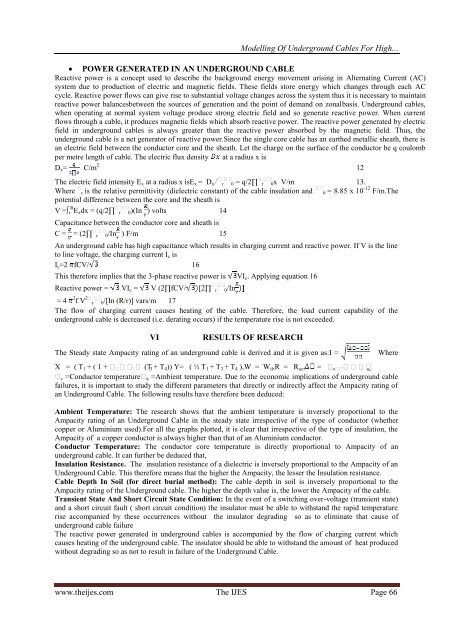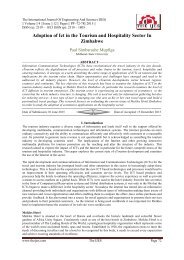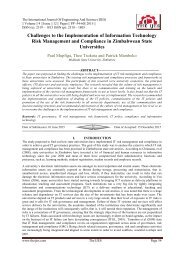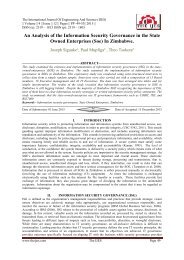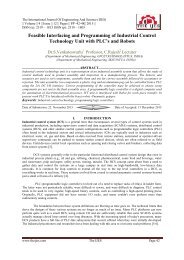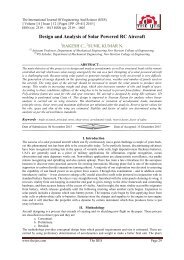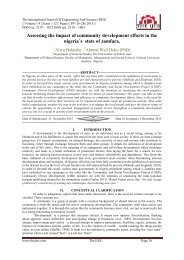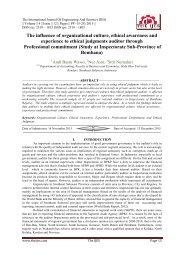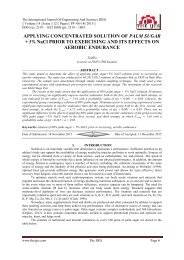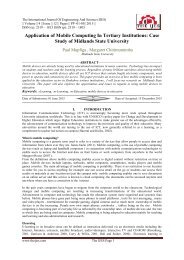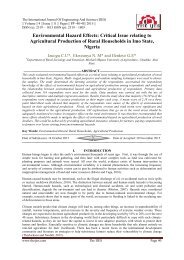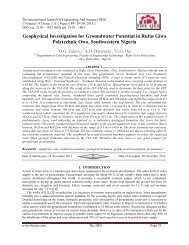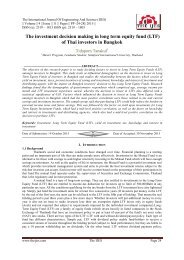Modelling Of Underground Cables for High Voltage Transmission
You also want an ePaper? Increase the reach of your titles
YUMPU automatically turns print PDFs into web optimized ePapers that Google loves.
<strong>Modelling</strong> <strong>Of</strong> <strong>Underground</strong> <strong>Cables</strong> For <strong>High</strong>...<br />
POWER GENERATED IN AN UNDERGROUND CABLE<br />
Reactive power is a concept used to describe the background energy movement arising in Alternating Current (AC)<br />
system due to production of electric and magnetic fields. These fields store energy which changes through each AC<br />
cycle. Reactive power flows can give rise to substantial voltage changes across the system thus it is necessary to maintain<br />
reactive power balancesbetween the sources of generation and the point of demand on zonalbasis. <strong>Underground</strong> cables,<br />
when operating at normal system voltage produce strong electric field and so generate reactive power. When current<br />
flows through a cable, it produces magnetic fields which absorb reactive power. The reactive power generated by electric<br />
field in underground cables is always greater than the reactive power absorbed by the magnetic field. Thus, the<br />
underground cable is a net generator of reactive power.Since the single core cable has an earthed metallic sheath, there is<br />
an electric field between the conductor core and the sheath. Let the charge on the surface of the conductor be q coulomb<br />
per metre length of cable. The electric flux density at a radius x is<br />
D x = C/m 2 12<br />
The electric field intensity E x at a radius x isE x = D x ╱ r 0 = q/2∏ r 0x V/m 13.<br />
Where r is the relative permittivity (dielectric constant) of the cable insulation and 0 = 8.85 x 10 -12 F/m.The<br />
potential difference between the core and the sheath is<br />
V =∫ r R E x dx = (q/2∏ r 0)(In ) volts 14<br />
Capacitance between the conductor core and sheath is<br />
C = = (2∏ r 0/In ) F/m 15<br />
An underground cable has high capacitance which results in charging current and reactive power. If V is the line<br />
to line voltage, the charging current I c is<br />
I c =2 fCV/ 16<br />
This there<strong>for</strong>e implies that the 3-phase reactive power is VI c . Applying equation 16<br />
Reactive power = VI c = V (2∏fCV/ [2∏ r 0/In<br />
= 4 2 f V 2 r 0/[In (R/r)] vars/m 17<br />
The flow of charging current causes heating of the cable. There<strong>for</strong>e, the load current capability of the<br />
underground cable is decreased (i.e. derating occurs) if the temperature rise is not exceeded.<br />
VI<br />
RESULTS OF RESEARCH<br />
The Steady state Ampacity rating of an underground cable is derived and it is given as:I =<br />
Where<br />
X = ( T 1 + ( 1 + (T 3 + T 4 )) Y= ( ½ T 1 + T 3 + T 4 ),W = W d ,R = R ac , = c a,,<br />
c =Conductor temperature a =Ambient temperature. Due to the economic implications of underground cable<br />
failures, it is important to study the different parameters that directly or indirectly affect the Ampacity rating of<br />
an <strong>Underground</strong> Cable. The following results have there<strong>for</strong>e been deduced:<br />
Ambient Temperature: The research shows that the ambient temperature is inversely proportional to the<br />
Ampacity rating of an <strong>Underground</strong> Cable in the steady state irrespective of the type of conductor (whether<br />
copper or Aluminium used).For all the graphs plotted, it is clear that irrespective of the type of insulation, the<br />
Ampacity of a copper conductor is always higher than that of an Aluminium conductor.<br />
Conductor Temperature: The conductor core temperature is directly proportional to Ampacity of an<br />
underground cable. It can further be deduced that,<br />
Insulation Resistance. The insulation resistance of a dielectric is inversely proportional to the Ampacity of an<br />
<strong>Underground</strong> Cable. This there<strong>for</strong>e means that the higher the Ampacity, the lesser the Insulation resistance.<br />
Cable Depth In Soil (<strong>for</strong> direct burial method): The cable depth in soil is inversely proportional to the<br />
Ampacity rating of the <strong>Underground</strong> cable. The higher the depth value is, the lower the Ampacity of the cable.<br />
Transient State And Short Circuit State Condition: In the event of a switching over-voltage (transient state)<br />
and a short circuit fault ( short circuit condition) the insulator must be able to withstand the rapid temperature<br />
rise accompanied by these occurrences without the insulator degrading so as to eliminate that cause of<br />
underground cable failure<br />
The reactive power generated in underground cables is accompanied by the flow of charging current which<br />
causes heating of the underground cable. The insulator should be able to withstand the amount of heat produced<br />
without degrading so as not to result in failure of the <strong>Underground</strong> Cable.<br />
www.theijes.com The IJES Page 66


